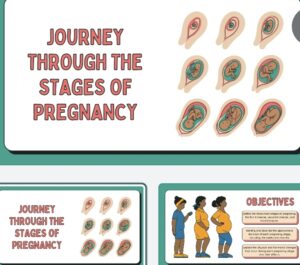Table of Contents
ToggleIntroduction Of Feotus :
The amazing process of fetal development marks the start of the human life journey. A tiny fertilized egg sets out on an amazing journey at the moment of conception, growing into a sophisticated organism over the course of nine months. This piece explores the complex phases of Feotus development, emphasizing the amazing turning points that form thebasis of human existence.

1. Conception and Early Cell Division Of Feotus
The journey commences when a sperm fertilizes an egg, forming a single-cell zygote. This zygote undergoes rapid cell division, forming a blastocyst within a week. The blastocyst is a sphere of cells with an inner mass that will become the embryo and an outer layer that will develop into the placenta.
2. Feotus Implantation and Formation of Germ Layers
Pregnancy begins when the blastocyst inserts itself into the uterine lining, usually on the sixth day following fertilization. The embryo differentiates into the ectoderm, mesoderm, and endoderm, the three main germ layers, as it grows. These layers provide the foundation for the complexity of the human body by giving rise to different tissues and organs.
3. Organogenesis: Creating the Blueprint Of Feotus :
During the third to eighth weeks, a period known as organogenesis, the basic structures of major organs and body systems begin to form. The heart starts beating, the neural tube develops into the brain and spinal cord, and limb buds emerge. This critical phase is susceptible to teratogens, substances that can cause birth defects, underscoring the importance of a healthy maternal lifestyle during pregnancy.
4. Development and Growth of the Fetus:
The fetus grows quickly as it enters the second trimester. The kidneys, liver, and lungs are among the organs that continue to develop as the skeletal system hardens. The fetus has the ability to hear sounds and see light by the end of the second trimester. As the nervous system continues to develop, movement increases noticeably during this time.
5. Viability and Late-Term Development:
Around the 24th week, the fetus reaches the point of viability, meaning it has a chance of survival outside the womb with medical assistance. The third trimester sees further refinement of organ systems, with the lungs preparing for independent breathing. The fetus keeps gaining weight and its brain develops significantly, forming complex neural connections among other things.
6. The Placenta as the Maternal-Fetal Interface
The placenta is essential to the exchange of nutrients, oxygen, and waste products between the mother and the fetus during pregnancy. This amazing organ, which develops from the blastocyst’s outer layer, acts as a lifeline for the developing fetus by giving it vital support.
7. Genetics’ Part in Fetal Development:
Fetal development is greatly influenced by genetic factors. The way the genetic material of the mother and father interacts during development determines the features and attributes of the growing fetus. Congenital disorders can result from genetic abnormalities, which highlights the significance of genetic screening and counseling during pregnancy.
8. Extrinsic Factors Affecting Fetal Development
Fetal development is influenced by a variety of external factors in addition to genetics, including nutrition, environmental exposures, and maternal health. Proper nutrition, adequate prenatal care, and abstaining from hazardous substances are critical for encouraging ideal growth and lowering the likelihood of complications.
Conclusion:
The process of fetal development is a delicate and intricate process that is showcased by the journey from conception to birth, which is a marvel of nature. Every phase, distinguished by particular turning points, aids in the development of a distinct person. Knowing this journey makes life more complicated and emphasizes how crucial it is to maintain a healthy lifestyle and receive prenatal care in order to protect the developing fetus and the mother.
